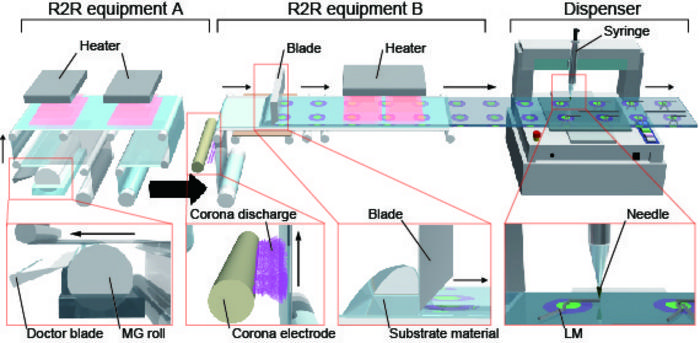Electronics have evolved over the years to supersede simply enhancing day-to-day life to becoming almost seamlessly integrated with daily life. People have become accustomed to wearable electronics, but what about stretchable ones? There is a growing demand for this type of technology, but the current methods are not easily scalable for mass production to make these devices available to the public. However, mass development may be possible using the roll-to-roll (R2R) process, which prints various layers on a flexible rolled substrate, cutting out the manual nature of the process. By rolling this type of electronic out into the market, the possibility for stretchable electronics and even smart packaging can become commonplace.

Credit: Yokohama National University
Electronics have evolved over the years to supersede simply enhancing day-to-day life to becoming almost seamlessly integrated with daily life. People have become accustomed to wearable electronics, but what about stretchable ones? There is a growing demand for this type of technology, but the current methods are not easily scalable for mass production to make these devices available to the public. However, mass development may be possible using the roll-to-roll (R2R) process, which prints various layers on a flexible rolled substrate, cutting out the manual nature of the process. By rolling this type of electronic out into the market, the possibility for stretchable electronics and even smart packaging can become commonplace.
Researchers published their results in Advanced Materials Technologies on June 9.
Conventional methods can make complex, multilayered patterned substrates themselves, but it does not have the high production capacity to extend that capacity to large-scale production. Therefore, it’s necessary to adapt to the dynamic nature of technology as demand for newer, better electronics arises.
“In this study, we conducted research and development for the mass production of stretchable devices based on the R2R production process. These technologies are important to promote market introduction in order to further develop the field of stretchable electronics, which is still in the research phase,” said Hiroki Ota, associate professor at Yokohama National University and author of the paper.
The R2R production process is a method of creating elastic substrates that are multilayered with different material layers and embedded electronics. This method allows for continuous production of the substrates, which contain elastic materials like hydro-gels or silicone, and liquid metal wiring. The process also involves a coating step and a step to prepare the material for wiring. The result is a single material that is flexible, elastic and functional.
Previously, R2R was a process used for newspapers and photography but now, it is being employed for the manufacturing of electronics such as organic solar cells, flexible electronic substrates and solar cells. This technology will serve as a basis for the future large-scale production of stretchable electronics, which can consist of wearables, smart packaging or soft electronics and everywhere in between.
In the study, 15 stretchable devices with light detection were produced and tested the ability to respond to light levels while being stretched. These materials were shown to maintain functionality even when being stretched by 70% of the substrate’s maximum. Additionally, devices equipped with thermistors (tools used to measure device temperature) appeared accurate when comparing the temperature of each compartment given by the device against the actual set temperature.
“The stretchable wiring technology has not been realized by the R2R process technology, and in the future, by linking the R2R production process technology for liquid metal wiring and substrates, the R2R process can realize the continuous and mass production of the stretchable device itself,” said Ota.
The evolution of uses of the R2R process has provided many opportunities for stretchable electronics and devices. So far, R2R processing on the elastic materials has achieved accuracy and continued performance when stretched. Researchers hope to see further developments in micropattern fabrication for higher resolution and improve the overall functionality of the process and its outcomes.
Hiroki Kawakami, Kyohei Nagatake, Sijue Ni, Fumika Nakamura, Tamami Takano, Koki Murakami, Ibuki Ohara, Yuji Isano, Ryosuke Matsuda, Hideki Suwa, Ryunosuke Higashi, Takuto Araki, Shingo Ozaki, and Hiroki Ota of the Department of Mechanical Engineering at Yokohama National University, Moeka Kanto and Kazuhide Ueno of the Department of Chemistry and Biotechnology at Yokohama National University, Masato Saito, Hajime Fujita, Tatsuhiro Horii and Toshinori Fujie of the Department of Life Science and Technology at Tokyo Institute of Technology contributed to this research.
The Japanese Science and Technology Agency (JST), JST CREST and FOREST, the Precursory Research for Embryonic Science and Technology, and Grant-in-Aid for Scientific Research A and B made this research possible.
# #
Yokohama National University (YNU or Yokokoku) is a Japanese national university founded in 1949. YNU provides students with a practical education utilizing the wide expertise of its faculty and facilitates engagement with the global community. YNU’s strength in the academic research of practical application sciences leads to high-impact publications and contributes to international scientific research and the global society. For more information, please see:
Journal
Advanced Materials Technologies
Article Title
R2R-Based Continuous Production of Patterned and Multilayered Elastic Substrates with Liquid Metal Wiring for Stretchable Electronics
Article Publication Date
9-Jun-2024



